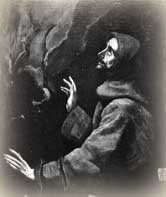
When Francis of Assisi was in his early forties, he gave up leadership of the Franciscans, the great order he had founded. This was not done in pique or bitterness but with a quiet acceptance that events had moved beyond him. His simple and stringent rule was too difficult for the many who had swarmed into the order because of his fame and the powerful preaching of his followers. They wanted the rule relaxed, and relaxed it would be.
If Francis thought he could now be just one of the brothers, he was mistaken. None had such zeal as he. Of none would such legends be told. To none other would such visions come.
He decided to spend some days before the Feast of the Assumption at Mt. Alvernia. In that wilderness a flock of birds settled around and upon him to the astonishment of his few companions and succeeding generations. At Mt. Alvernia, Francis decided he needed more solitude. The sense of his own sin was heavy upon him, and he longed for a taste of heaven in order to bear the pain of his past wrongdoing. He found a lonely spot in the forest across a chasm. Only one man was allowed to approach him in his solitude: his spiritual son Leo; and even Leo was told to call out and receive permission before crossing the limb which served as a bridge to Francis' isolation.
The brothers feared for Francis. He was gravely ill. One night Leo approached the chasm and called out. Francis did not answer. Leo called again. Perhaps the master had taken ill. Fearful of disobedience and yet even more fearful that the holy leader might be dying unattended, Leo crossed the limb.
Francis' cell was empty. Yet the moon was bright. Leo went some way and heard a voice. It was Francis, praying, "Who are you, my dearest Lord? And who am I, a most vile worm and your most unprofitable servant?" Leo saw a light shine down upon Francis and knew that words were spoken to him, although he could not hear them. Francis raised his hands into the light. The light disappeared. Leo turned to creep away, but Francis heard. He challenged him, for he was almost blind. Leo confessed he had broken the command. Francis was gentle. The transgression was from love.
Francis told Leo that he had been commanded to give three gifts, and these three gifts were as golden balls in his bosom: poverty, chastity and obedience. He had held them up to the Lord. The two men then read and prayed together. Then on the morning of this date, September 14, 1224, the day of the Feast of the Holy Cross, as Francis was communing with the Lord, a Seraph appeared to him. The figure of Christ crucified appeared between his wings. Joy and agony suffused Francis. His prayers for forgiveness, to share Christ's sufferings, to be purified had been heard. When the angel left, in what is regarded as one of the classic experiences of Christian history, Francis' hands feet and sides bore five wounds, the marks of the stigmata. Two years later he died.
Bibliography:
- Bell, Mrs. Arthur. Saints in Christian Art. London: George Bell, 1901 - 1904. Source of the image.
- Durant, Will. The Age of Faith; A history of Medieval civilization--Christian, Islamic and Judaic--from Constantine to Dante: AD 325 - 1300. The Story of Civilization, Part IV. New York: Simon and Schuster, 1950.
- "Francis of Assisi." Christian History. No. 42
- oudge, Elizabeth. My God and My All. New York: Coward - McCann, 1959.